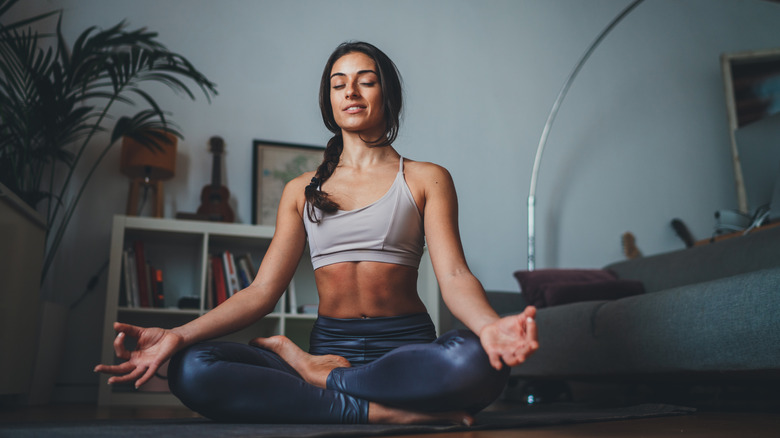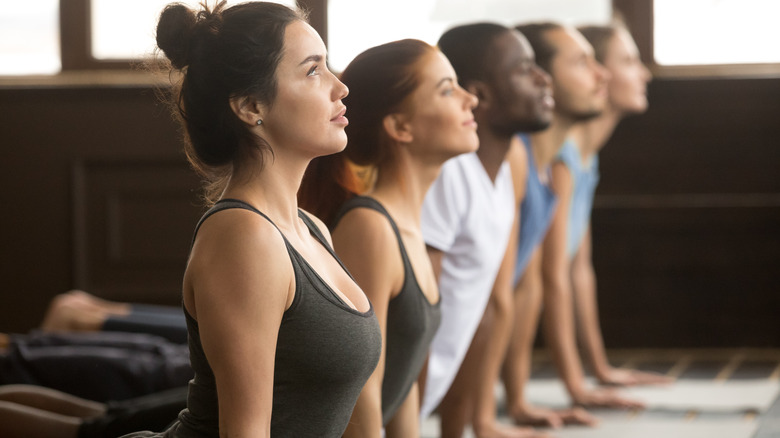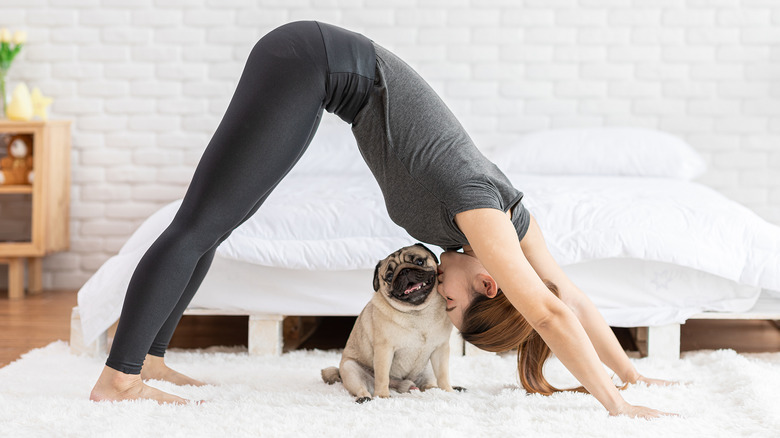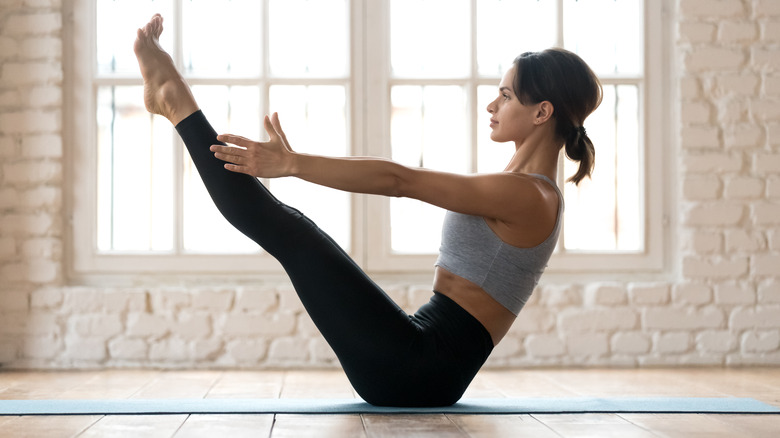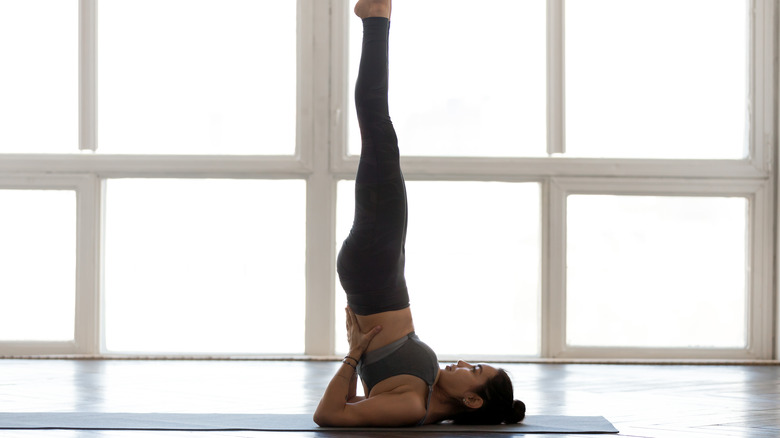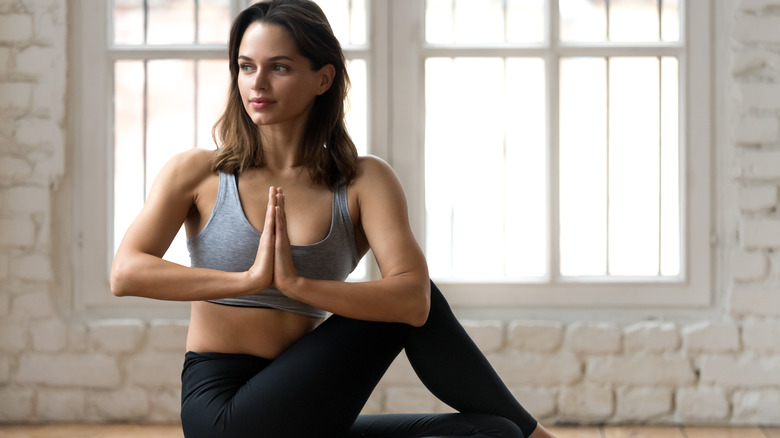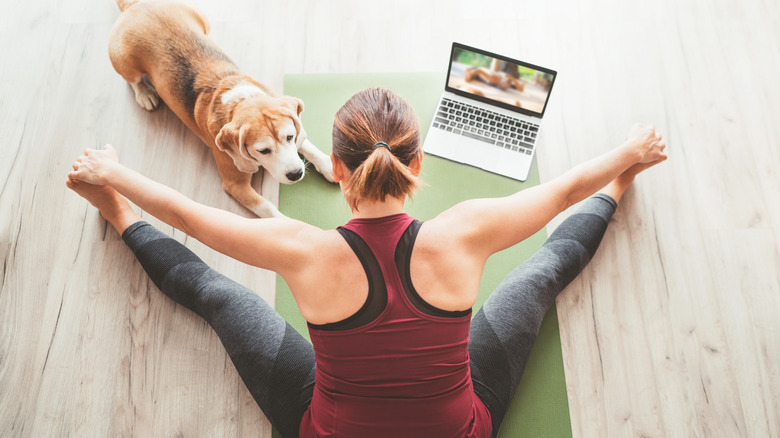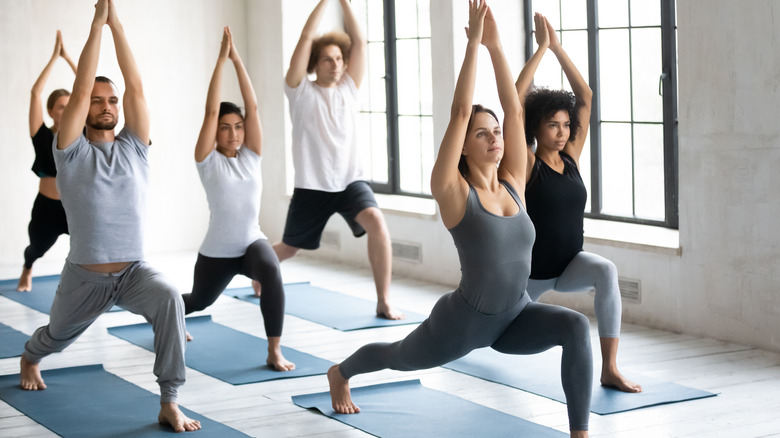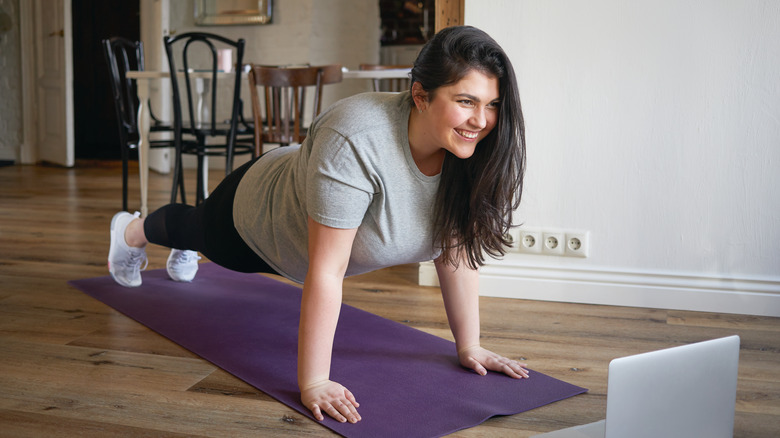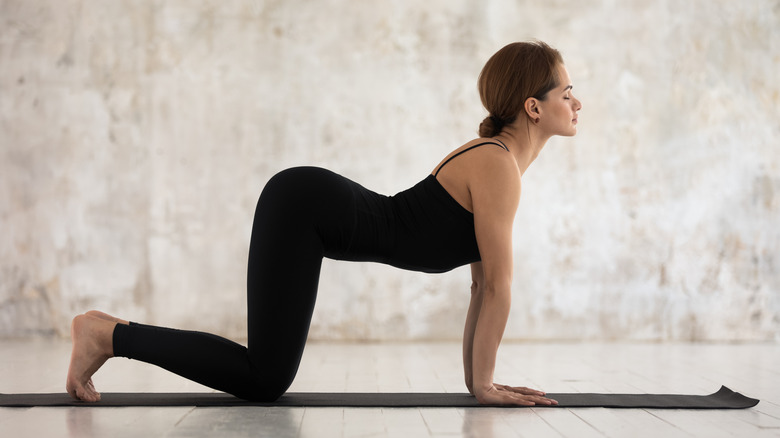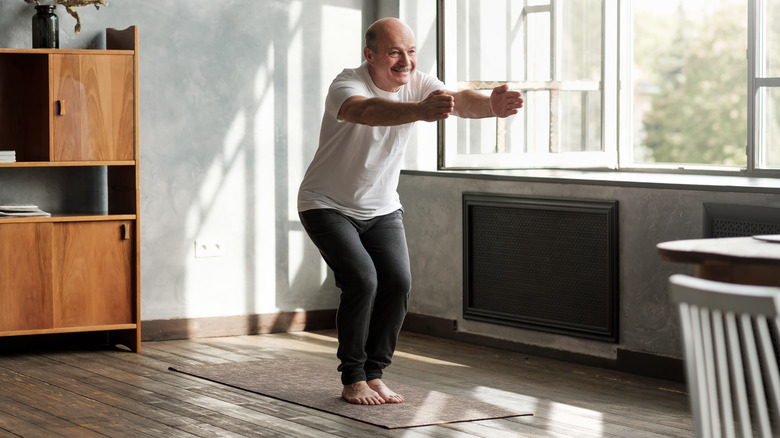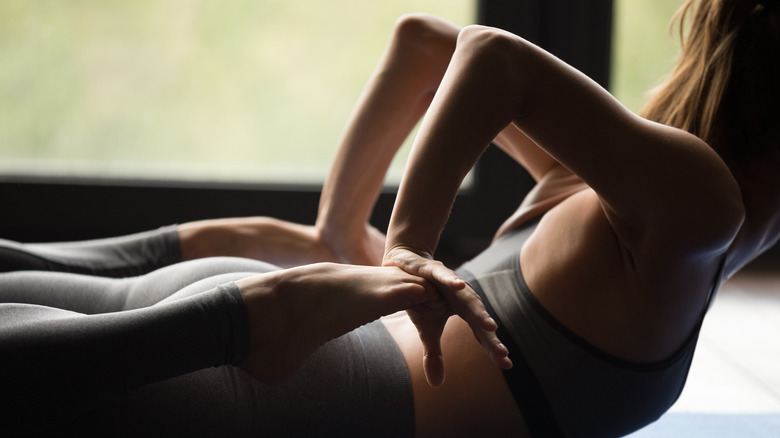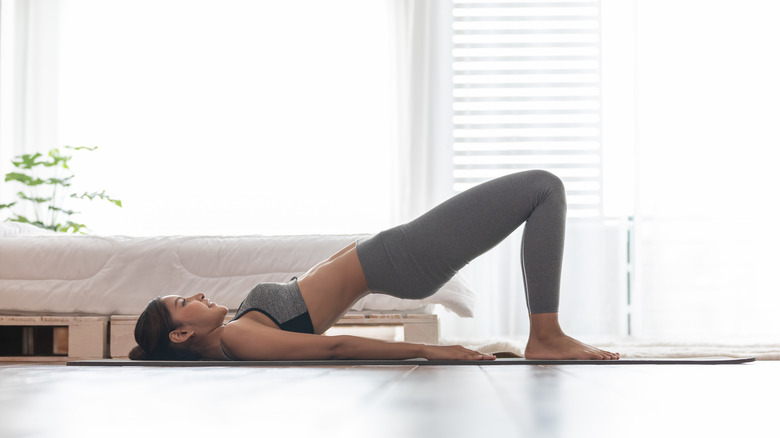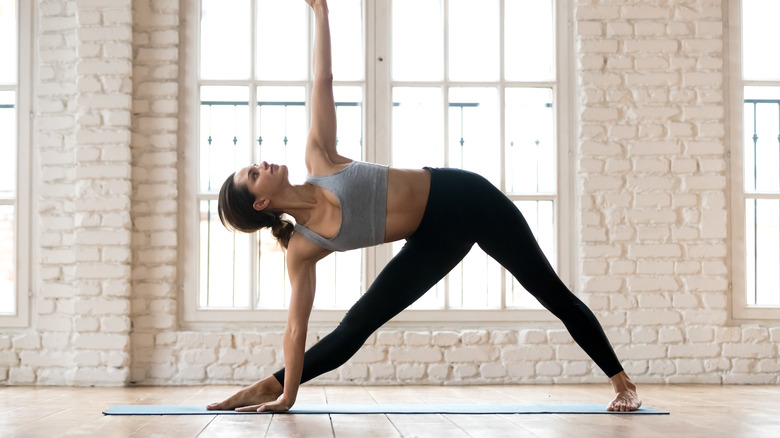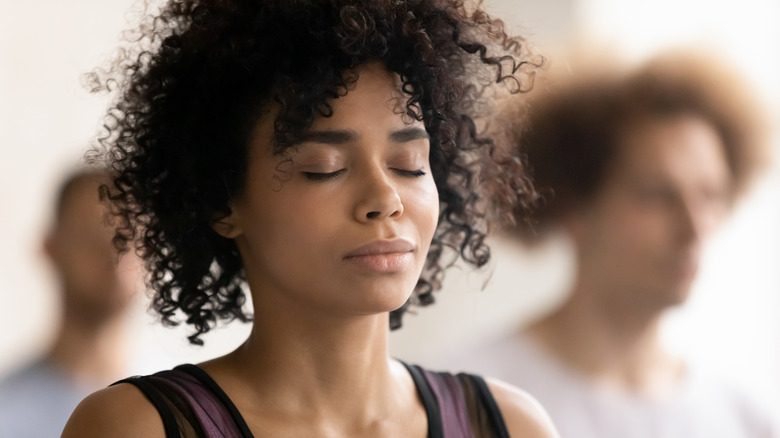The Best Yoga Poses If You Want To Lose Weight
Looking for a workout routine that mixes meditation and mindfulness with calorie-burning? While yoga is known for its mind and body connection, it can actually be a big benefit to your fitness routine. In fact, studies have shown that yoga practice resulted in weight loss and lesser risk of heart disease in overweight men, as well as weight loss in women (via Insider). Yoga also is known for its added benefits of relaxation, stress reduction, increased mobility, and more.
Yoga can serve as a calorie burner, but how much varies on the type of yoga practice. Bikram, hatha, and vinyasa — to name a few — vary in intensity. Generally, yoga will burn between 180 to 360 per hour (via Gaiam). Some of the more intense yoga practices like Bikram can lead to a calorie burn of up to 500 calories, as these classes are typically 90 minutes long and are held in a "hot" studio of 105 degrees and 40 percent humidity that is sure to make you sweat, according to Insider. But before you jump right into intense hot yoga practices, check out these poses that can help you lose weight. Some are as simple as a stretch, while others kick up the heat so you feel the burn immediately.
Sun salutations
Sun salutations originated from the Hindu tradition of honoring the sun with 12 stations and eight different postures (via Yoga Journal). These poses are integral for vinyasa flows and consist of multiple poses and breathing transitions that add up to a full-body workout. You can change your pace to increase the intensity, generating heat and burning more calories, or slow it down if you want a more gentle, meditative practice. It can be a warm-up to more advanced poses, or a great all-in-one workout.
Sun salutations combine positions like forward bend, plank, cobra, and downward-facing dog with additional variations available to suit your desired flow. It is recommended to start out with three to five rounds of sun salutations and gradually build up to 10 or 15, according to experts at Yoga Journal. Interested in trying out sun salutations? Check out this video tutorial provided by Healthline to follow along in this multiple-pose flow.
Downward-facing dog and upward-facing dog
You've probably seen your dog stretching in a similar pose, inspiring the name. Part of the sun salutation flow, downward-facing dog and upward-facing dog are great poses for your spine, back, and overall posture (via MasterClass and Daily Burn). However, if you engage your core, it can be impactful for your whole body (via Insider).
Downward-facing dog begins with your hands and feet on your mat with your hips up and your butt up into the air. This pose also works the arms since you hold yourself up, allowing you to skip the dumbbells at the gym for toning exercise. Upward-facing dog is the opposite, as it is more of a lower back-stretching pose that engages your core (via MasterClass). What you may not realize is this pose also opens your chest, strengthens your back and arm muscles, and even lengthens your spine. To do the upward-facing dog, lay facedown with your palms on the floor next to your stomach, and raise your chest up and forward, using your hands to press down into the mat. Raise your hips and legs as well until you're supported by your hands and feet (or toes).
Boat pose
The boat pose engages the whole body, especially the core (via Healthline). It is also known as a stress-reliever. You may think it doesn't look as grueling as some other yoga poses, but the research backs up the fitness benefits of boat pose. Studies have also found that boat pose can help lead to fat loss in as little as 12 weeks by boosting your metabolism (via Health Shots).
You may find it challenging at first because the boat pose requires balancing on your tailbones while stretching out the arms and legs. But keeping with this pose will have your core strengthened, enabling you to balance easily in no time. A successful boat pose results in your body looking like a deep V with your legs and arms lifted. It is recommended to hold this pose for 30 seconds and repeat up to five times for optimal effects, according to Health Shots.
Shoulder stand and fish pose
The shoulder stand and fish pose are two poses that combine for a flow that boosts your metabolism and brings other health benefits (via Track Yoga). The shoulder stand is considered an inversion that balances the thyroid, brings blood flow to the brain, and calms the nervous system. It is heavy on the neck and spine, so you want to be mindful of your form and head placement to keep yourself safe. To go into the shoulder stand, lay on your back with your feet facing a wall, then bend your knees placing your feet on the wall at a 90-degree angle, lift your pelvis, and walk your feet up the wall. For a more advanced version, you can lift your legs fully off the wall, pointed straight upward, with your arms providing support on your back.
The fish pose counteracts the shoulder stand as a back-bending heart-opener, stretching out the muscles that the shoulder stand stresses. You don't have to move directly to fish pose, but if you choose to, return to your back with your knees bent and feet on the floor. Lift your pelvis and rest your hands under your bottom as you press your shoulder blades together and lift up your chest and head, creating an arch in your back. Yoga Journal has step-by-step instructions and some modifications by fitness level that may be helpful for fish pose.
Twisting poses
There are numerous yoga poses that involve a twist of some sort. Belly twist, spinal twist, and revolved triangle are a few options for these fat-burning poses involving a twist (via Yoga Basics). You may be wondering how a simple twist can bring health benefits. As it turns out, twisting poses act as a detox for your internal organs, relieving tension and helping you digest more easily (via Aura Wellness Center and Healthline). The benefits don't stop there – the twisting poses burn fat and strengthen your abdominal muscles, so you feel better from the inside out.
The spinal twist, sometimes called the seated twist, twists your upper body for a side stretch — it is important for flexibility and can be a good beginner pose, according to Yoga with Dakota. But you want to be careful if you have issues with your spine or shoulders. You can even add a twist to another pose like a lunge after a warm-up routine with sun salutations, according to Aura Wellness Center.
Mill churning pose
While this pose may look like a simple stretch, yogis say that this posture — which mimics the ancient wheat grinding motion from India — can actually be a good toning exercise for your core (via Art of Living). Among the benefits of this pose are the workout of the abdominal, back, and arm muscles, as well as the easing of sciatica pain. You also are opening up your chest and stretching your groin with this pose.
To do the mill churning pose, you will sit on your bottom with your legs spread out (Yoga with Dakota suggests this pose can also be performed with your feet together). Clasp your hands together and make circular motions that stretch toward your feet as far as is comfortable for you. If you are using proper form with your neck straight, you should feel some pressure on your abdominals. Yoga with Dakota recommends doing this pose 25 times in both clockwise and counterclockwise directions.
Warrior poses
If you've ever done a workout class before, you likely are familiar with lunge exercises as leg-burners. The warrior one and warrior two positions are lunge poses that kick your whole body into gear, focusing on leg and hip flexibility and endurance (via Ekhart Yoga). But the calorie-burning comes from how these poses hone in on large muscle groups, yoga instructor Rebecca Pacheco tells Women's Health.
Warrior one can begin from a mountain pose (or standing tall), as you step your foot back at a 45-degree angle, keeping your upper body facing forward (via OpenFit). Bend your front knee to a 90-degree angle in alignment with your ankle, ensuring you don't push your knee over your toes. Finally, lift your arms up along your ears. Warrior two is similar to warrior one, but your hips face squarely to one side as you open your arms into a T-shape, one extended backward and the other forward, and look forward over your fingertips.
If you love warriors one and two, check out warrior three for a pose that works on your balance and tones the back muscles, core, and legs (via Fitness 1440). Warrior three starts from a standing position with legs together and arms raised over your head. As you lift one of your legs backward, lean your torso forward, balancing on the standing leg.
Plank pose
Plank poses are popular in numerous different workouts and can feel like they last an eternity. But the pain is worth the gain, according to experts. "This posture is a surefire way to improve your shoulder and core stability and strength," yoga teacher and author Kathryn Budig tells Prevention. "It isn't the easiest posture to maintain, so feel free to modify with your knees on the ground as you cultivate more strength."
Start on your hands and knees with hands on the mat shoulder-width apart. Step your feet back hip-width apart, engaging your core to keep your body in a straight line. Hold this for up to 60 seconds and repeat up to five times, according to Prevention. If you want to challenge yourself with another plank pose, try the side plank to build your obliques and shoulders. Budig tells Prevention that the side plank is one of the best calorie-burning poses, and can even help with lower back pain. After getting into a regular plank position, turn sideways by rolling one of your feet to the outer edge, stacking your other foot on top and reaching your opposite arm upward.
Cat-cow pose
Some poses can be daunting if you are a beginner yogi. Thankfully, poses like the cat-cow are feasible for a variety of fitness levels. The cat-cow offers both a spinal stretch and abdominal toning at the same time, without being too high-impact (via Health Shots).
The cat cow starts on your hands and knees, similar to the plank pose, but you should drop your stomach toward the ground, keeping your chin and chest upward. The end result should have your belly dropped down like a cow. After the cow pose, the transition into the cat pose has you sucking your stomach in, pulling your belly up toward your spine. Your back should round upward like a cat stretching — hence the name. Doing the cat-cow pose frequently in your practice can also help alleviate back pain and improve your posture, both long-term effects that last after your weight goals are met (via Yoga with Adriene).
Chair pose
The chair pose has similar benefits as a squat, as it works your leg muscles including the glutes, quadriceps, calves, and can help strengthen your spine and ankles (via Healthshots). Yoga teacher Kathryn Budig tells Prevention the chair pose is great for building strength in not just your lower body, but your core and mind. To try out the chair pose, stand with your feet touching, drop your hips, and bend your knees as if you are sitting back into an imaginary chair. Raise your arms overhead shoulder-width apart and look straight forward, holding for several breaths or more. Buding says to repeat this pose 10 times.
If you are looking for a deeper burn, turn this position into a revolved chair pose by adding a twist to kick up your digestive system (via Prevention). Deviate from the regular chair pose for 8 breaths before resetting into chair pose and tackling the other side.
Frog pose
The frog pose is another one that has you looking like the animal it is named after. The perks of the frog pose are stretching and toning of your abs, opening your hips and groin muscles, easing back pain and tension, as well as increasing circulation and improving your posture (via Verywell Fit). It is considered a more advanced pose, so beginners should exercise caution.
For those who want to attempt frog pose, start on your hands and knees. Move your knees out to the side and flex your ankles. Then lower down onto your forearms, feeling a strong stretch and taking any necessary modifications needed for your comfort level. Frog pose may also be too intense for those with knee, hip, or groin injuries, and should not be attempted by pregnant women after the first trimester. Be sure to consult with your yoga instructor and medical team if you have any concerns.
Bridge pose
The bridge pose is known for its wellness benefits on your body, both internally and externally. The pose has a positive effect on the thyroid gland and also gives your metabolism a boost (via Yoga with Dakota), and can aid in digestion (via StyleCraze). Some even say bridge pose can cure sinus issues and help with circulation. As far as toning your muscles, be prepared to feel the burn in your legs and arms, as well as in the chest, neck, and spine.
To try the bridge pose, start out on your back with your feet down and knees pointed at the ceiling, arms laying by your side. Lift your hips upward, using your arms, shoulders, and feet for support. Hold and then bring your hips back down. You can choose to hold the pose for a set amount of time, or have your pose match your breath depending on your practice preferences.
Triangle pose
While triangle pose may not seem like it's a calorie-crusher, the movement actually is working your muscles via a twisting motion – Yoga By Dakota even calls it the best workout your abs can get. Triangle pose stretches your abs to boost your digestion and burn fat in that pesky stomach region. It also activates your obliques, according to Health Shots.
But the lower body isn't left out of the workout. When done correctly, this pose engages the legs and the arms for toning (via Do You). If you want to try the triangle pose, Health Shots recommends starting with your feet approximately three feet apart. Turn out the foot on your back leg and bend downward, trying to reach your front foot with your arm. Reach your other arm up toward the sky, deepening your stretch through your whole body. You can repeat this pose multiple times, holding it for up to 30 seconds.
Breathing and Mindfulness
The acts of breathing and meditating may not seem like a workout, but they have their own set of perks. Breathing is a large part of any type of yoga practice, as it gives your lymphatic system a boost by ousting toxins and eliminating water weight (via Gaiam). Taking this mental "breather" and listening to your body can also help you determine if you are actually hungry or if you are eating emotionally, YogaTuneUp creator Jill Miller tells Gaiam. This can lead to weight loss via dietary changes. And luckily, these benefits are available even in gentler forms of yoga, which are more accessible to beginner yogis, or for people struggling with injuries or mobility issues (via Yoga Basics). Gentle yoga is a hatha flow that is performed slowly, using less difficult poses to focus on stretching and relaxation. And though gentle yoga requires less physical exertion, it still regulates breathing, digestion, and hormones, according to Gaiam.

